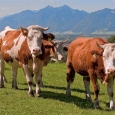 On June 25-27 the European Dairy Farmers (EDF) held its annual congress in Winterthur, Switzerland, with the theme “Tradition Meets Market”. Swiss dairy production is particularly interesting with regards to the theme as they have a strong tradition within dairy production and because they left the milk quota system in 2009. On the agenda were presentations, workshops and farm visits. Much focus was put on the consequences of the abolishment of milk quotas as the EU will leave the quota system next year and there are many speculations on possible consequences.
On June 25-27 the European Dairy Farmers (EDF) held its annual congress in Winterthur, Switzerland, with the theme “Tradition Meets Market”. Swiss dairy production is particularly interesting with regards to the theme as they have a strong tradition within dairy production and because they left the milk quota system in 2009. On the agenda were presentations, workshops and farm visits. Much focus was put on the consequences of the abolishment of milk quotas as the EU will leave the quota system next year and there are many speculations on possible consequences.
Swiss dairy: one industry two markets
Swiss dairy production is different compared to other European countries as there are many small holder farmers and many cheese producers in mountainous locations. Switzerland has 584,000 cows, 530 cheese factories and 23 490 dairy farmers which produces about 4 million tonnes of milk. As in other parts of Europe the numbers of farms are decreasing but the number of cows is stable.
Today’s Swiss dairy market is divided into two. One is a closed market for milk and fresh dairy products, which are protected from competition through increased domestic milk prices and greater border protections. Since the removal of quotas in 2009, the protection has increased with 15%. A challenge for the future will be to reach free trade agreements for dairy products. Switzerland’s high domestic production costs and high consumer prices mean they will be facing challenges in staying competitive on the international market. In order to justify the higher prices it will be important to communicate the high quality and the low cell count of Swiss milk as value added.
The other market is the cheese, which is open to competition from EU producers and prices for standard cheeses are close to an EU level. The cheese producers still receive subsidies from the government.
Abolishment of quota system
With the abolishment of quotas Swiss dairy farmers have adjusted to new challenges and developed new strategies to stay competitive. One strategy is to obtain a higher milk price and to deliver high quality (A-grade) milk to cheese producers. 1/3 of Swiss milk is produced without silage from non-pasteurized milk in order to respond to different PDO products like Emmentaler, Gruyére or Appenzeller.
The milk price decreased before the abolition of quotas mainly due to the financial crisis and declining milk prices all over Europe, but today the situation has stabilized and has not resulted in a lower milk price. There is a stable difference between milk prices in Switzerland and the EU but both are related and following the same trends. The Swiss milk price is highly dependent on the international dairy market.
The domestic production has increased by 7% between 2007 and 2013 with a stable domestic demand and Switzerland is increasing its export volumes of milk products with a subsidised price in order to reduce price-pressure on the domestic market.
Next year’s EDF congress will take place in Rostock, Germany. Thanks to Delaval for this summary!

